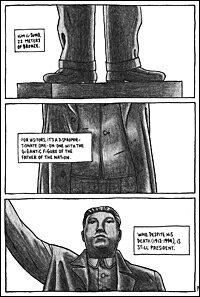Throughout the course of my English Literature degree path, one thing I have become accustomed to is that, in order for something to be "remarkable" it had to be a literary work of genius with specific literary techniques and little to no pictures. Everything I studied seemed to be 500 pages of black and white text bound together to make one complete masterpiece. That is, until I enrolled in a graphic novel course. That is when my whole perspective of literature changed. Suddenly, literature wasn't confined to books that never seemed to end or stories that used language that the modern world is so unfamiliar with.
So, how does a graphic novel become "remarkable?" Let's take a look at a story called Pyongyang by Guy Delisle. This is a graphic novel that takes journalism, combines it with a memoir, and then adds a unique artistic element that only further enhances its profound ability to tell a story. Pyongyang is a graphic novel about a man from Canada who travels to North Korea for work. This novel is the author's recollection of his experience in the country and how it affected him.
After reading an excerpt from Pyongyang by Guy Delisle, it is quite clear to me that as an American, I am very ignorant of the world outside of the states. Delisle takes us on a journey into North Korea, a country so cut off from the rest of the world that none of us truly know what a day in the life must be like. The author puts himself into the comic in order to show his personal account of the country. From the very first few scenes, it is clear the North Korea (from this author's point of view) is very strict and bland. No entertainment, no contact to the outside world. Just a plain hotel room with very plain people. At every turn, it seems that Delisle finds a soldier keeping watch. It's too clean; like a hosptial from a horror movie. One scene that struck me as significant was when the author arrived at the statue of the Korean leader. Up to this point, the comic artistry has been very simplistic with few detailed images. But once we go the the statue, suddenly the imagery is wonderfully detailed in order to capture the true essence of Kim Il-Sung. This important addition was able to convey the exact importance of this leader to the people of North Korea and the priorities of the country as a whole. Although we do see idolization of certain presidents in the states, it is rare that we see citizens placing flowers at the foot of their statues. Delisle's text is very straight and to the point. It is obvious that he feels uncomfortable and is trying is best to be respectful of the culture. This text, in combination with the simplistic design of the panels, creates the overwhelming feeling of being an outsider. Reading this, I almost feel like I myself am being constantly watched. My level of joy was immediately reduced in the first few pages of the excerpt.
Delisle's ability to give us a first hand look at such a secluded country is something that can only be done inside a graphic novel. His artistry, combined with his diction, allows us to feel immersed in the story, as if we were in the country ourselves. It makes you uncomfortable. It makes you paranoid. It makes you appreciate what you have.

Comments
Post a Comment